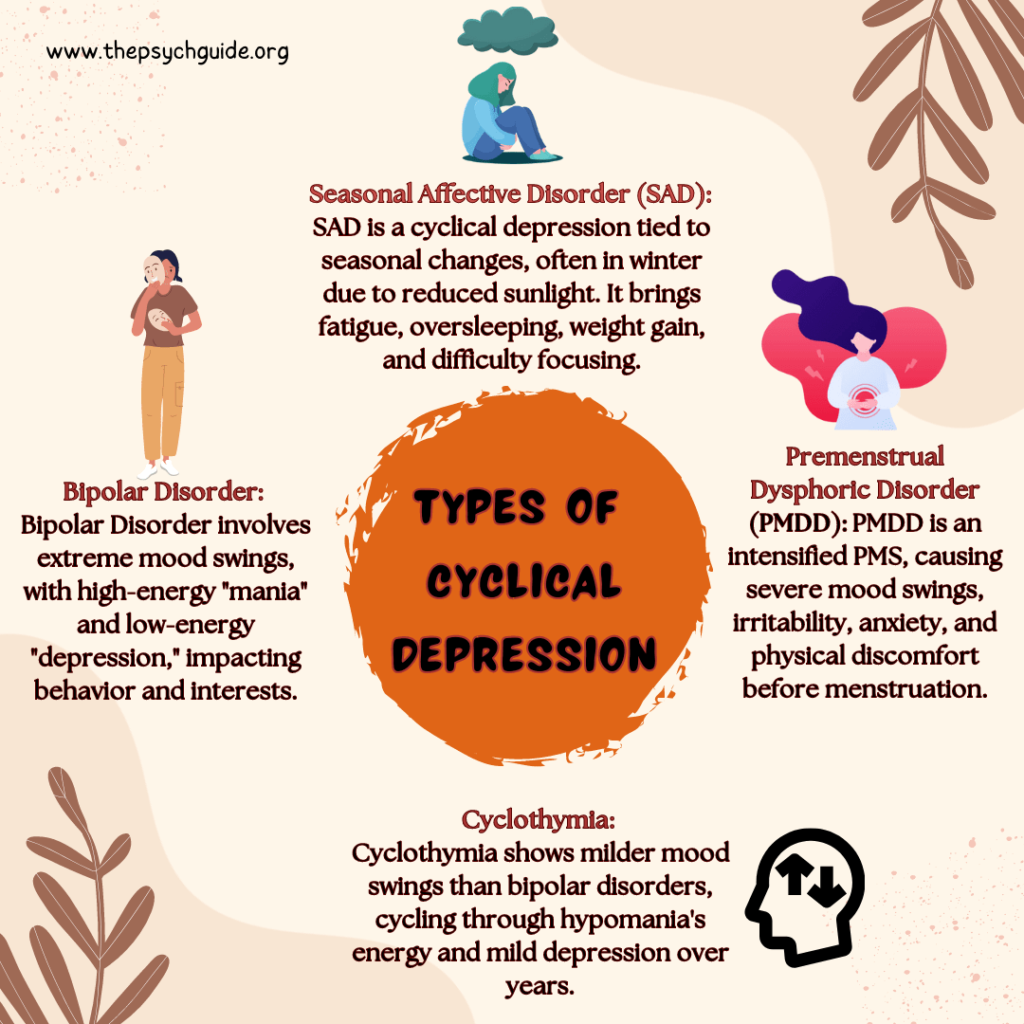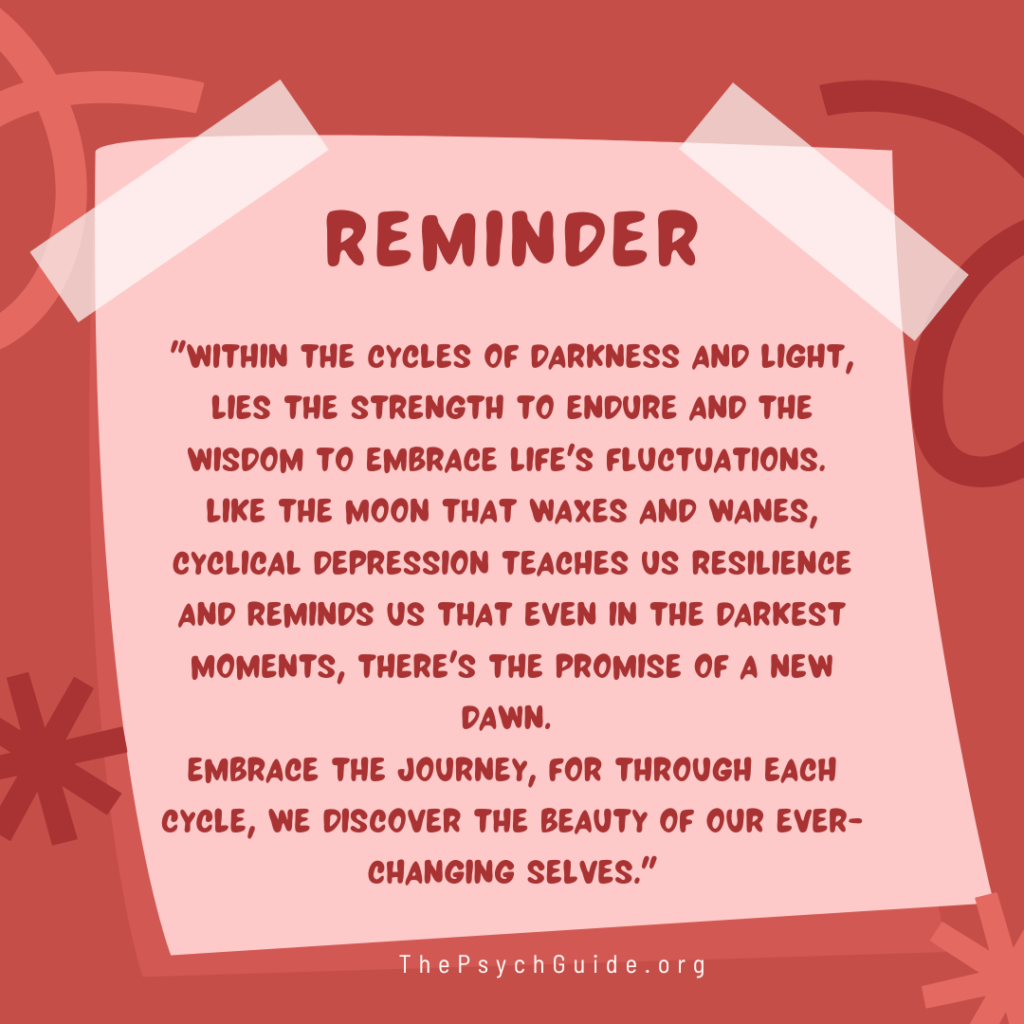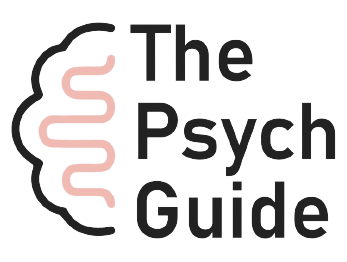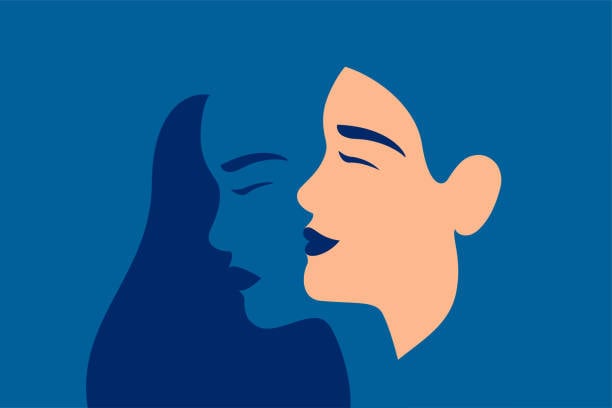If you have noticed that your depressive symptoms seem to come and go in cycles, you have found the right place.
Cyclical depression is one of the most common types of depression, but it can take many different forms. The symptoms of cyclical depression might appear in numerous aspects of one’s life, due to a variety of conditions, such as bipolar disorders and seasonal changes.
When we talk about “depression,” it’s not a one-size-fits-all concept. Depression comes in various forms, affecting people differently. Some might experience deep sadness for a few weeks, while others face milder, longer-lasting feelings of unease.
But what if you notice a pattern? What if your feelings of depression come and go like waves?
Although mental health experts might not use the term “cyclical depression,” it’s a way to describe when depression follows a cycle—sometimes it’s intense, other times it’s more manageable.
Understanding this cycle of ups and downs is the main focus of this article. It’s more than just a phrase; it’s a way to explain how some people go through depression.
So, if you’ve ever noticed your mood cycling, keep reading. We’ll help you grasp what’s happening and how to seek the support that best suits your situation.
Table of Contents
ToggleWhat is Cyclical Depression?
Cyclical depression, also known as recurrent depression, refers to a type of mental health condition where individuals experience repeated episodes of depression over time. These episodes occur in cycles, with periods of feeling very sad and low (depressive episodes) followed by periods of feeling better (remission) or in an elevated state (Mania). The cycle can repeat throughout a person’s life, and the number and frequency of episodes may vary among individuals.
Diagnosing cyclical depression can be challenging due to the nature of these disorders and their resemblance to other conditions. Because of this, cyclical depression is frequently misunderstood or linked to other types of natural mood swings, most frequently premenstrual syndrome (PMS) or bipolar disorder.
Cyclical depression frequently appears alongside other diseases. For instance, individuals with obsessive compulsive disorder (OCD) may experience the symptoms of cyclical depression as a result of their OCD-related high anxiety and recurrent panic episodes. Due to the disruption they bring to everyday routines, these symptoms might lead to recurring depression episodes. Similar to this, fluctuating depressive episodes can be a result of a post-traumatic stress disorder (PTSD) diagnosis for people who have it. These episodes eventually cause cyclic depression.

Types of Cyclical Depression:
The phrase “cyclical depression” isn’t a recognized mental health disorder. Nevertheless, certain forms of depression do have a consistent pattern. Rather than being there every day, these symptoms appear and disappear in a pattern.
We’ll discuss below four forms of depression that have cyclical symptoms:
1. Seasonal Affective Disorder (SAD):
Seasonal Affective Disorder (SAD) is a type of Cyclical depression that happens during certain seasons, usually in the fall and winter when there is less sunlight.
SAD is estimated to affect about 5% of the population in the United States, and its prevalence is higher in regions with long, dark winters and lower sunlight exposure.
It can last for a few months and start getting better in spring and summer. People with SAD might feel tired, lack energy, sleep more, gain weight, and find it hard to focus. Some individuals might also crave carbs and feel more sensitive to being rejected.
2. Bipolar Disorder:
Bipolar Disorder is a mood problem where someone’s feelings and energy levels go up and down a lot. They might have super high moods called “mania” and really low moods called “depression.”
These ups and downs can last for days or weeks. During the high times, they might think they can do anything and do risky stuff. When feeling low, they may lose interest in things they usually enjoy.
3. Cyclothymia:
Cyclothymia, also known as cyclothymic disorder, is a mood disorder characterized by cyclical changes in mood that are less severe than those seen in bipolar I or bipolar II disorders. Individuals with cyclothymia experience fluctuating periods of hypomania (elevated mood) and mild depression (low mood) over an extended period, typically lasting for at least two years in adults (one year in adolescents).
During hypomanic episodes, individuals may feel more energized, confident, and motivated than usual. They may engage in increased social activities, talk more, and take on more tasks or projects.
During depressive episodes, individuals may feel sad, hopeless, and lack energy. They may lose interest in activities they once enjoyed and find it challenging to experience pleasure in daily life.
4. Premenstrual Dysphoric Disorder (PMDD):
Premenstrual Dysphoric Disorder (PMDD) is a super intense kind of premenstrual syndrome (PMS). It affects some women before their periods.
The symptoms show up during the days before their period and usually go away when the period starts. PMDD symptoms include big mood swings, irritability, sadness, anxiety, and physical issues like bloating.
These symptoms can be so strong that they make it tough for a woman to do her normal daily stuff.
Common Symptoms Of Cyclical Depression Across All Types
1. Loss of Interest or Pleasure:
People with cyclical depression often lose interest in activities they once enjoyed. Hobbies, social interactions, and other pleasurable experiences may no longer evoke joy or excitement, contributing to a sense of disconnection from the world around them.
2. Changes in Appetite or Weight:
Cyclical depression can cause significant changes in appetite, leading to either overeating or loss of appetite. This change in eating habits can result in weight gain or weight loss, affecting self-esteem and body image.
3. Sleep Disturbances:
Sleep disturbances are common in cyclical depression. Individuals may have trouble falling asleep, staying asleep, or experience oversleeping (hypersomnia). This disruption in sleep patterns can exacerbate other symptoms and lead to fatigue and irritability.
4. Fatigue or Loss of Energy:
A pervasive sense of fatigue and lack of energy characterizes cyclical depression. Everyday tasks may feel exhausting and overwhelming, making it challenging to carry out daily responsibilities.
5. Feelings of Worthlessness or Guilt:
Those with cyclical depression may experience feelings of worthlessness or excessive guilt, often without a rational basis. They may be overly self-critical and blame themselves for circumstances beyond their control.
6. Psychomotor Agitation or Retardation:
Some individuals may experience psychomotor agitation, where they feel restless, fidgety, or have an urge to keep moving. In contrast, others may experience psychomotor retardation, where their physical and mental processes slow down, leading to a lack of motivation and reduced movement.
7. Suicidal Thoughts:
In severe cases, individuals with cyclical depression may experience thoughts of death or suicide. It is essential to take these thoughts seriously and seek immediate professional help if someone expresses such feelings.

Is Cyclical Depression and Cyclothymia the Same?
“Cyclical depression” and “cyclothymia” are not the same thing.
“Cyclical depression” is not a specific clinical term or recognized diagnosis in the field of mental health. It appears to be a term used informally to describe a pattern of depression with recurrent episodes. In a clinical context, professionals would typically refer to it as “recurrent depression” or “recurrent major depressive disorder,” where individuals experience multiple episodes of major depression with periods of remission in between.
On the other hand, “cyclothymia” is a distinct clinical diagnosis recognized in the Diagnostic and Statistical Manual of Mental Disorders (DSM-5). Cyclothymia is a mood disorder characterized by chronic and fluctuating mood changes, involving periods of hypomania (elevated mood) and mild depression (low mood) over an extended period.
In summary, “cyclical depression” does not have a specific clinical definition, while “cyclothymia” is a recognized mood disorder characterized by cyclical mood swings involving hypomanic and depressive states.
What Distinguishes Cyclothymia From Bipolar Disorder?
These two circumstances can be separated by the following points:
- You never encounter enough symptoms of cyclothymia to satisfy the diagnostic criteria for bipolar disorder. Instead, you might only ever experience one, two, or three depressive symptoms at a time.
- Cyclothymic symptoms are typically less severe than bipolar disorder symptoms.
- Any amount of time can go between mood episodes in people with bipolar illness. Yet for at least two years, at least 50% of the time, cyclothymia symptoms continue to be present. Periods without symptoms won’t last for more than two months.
Considering that cyclothymia might increase your risk of subsequently having bipolar disorder, seeking help as soon as you start to experience symptoms is a wise choice.
Treatment .
Psychotherapy.
- You may learn symptom coping skills, how to deal with upsetting thoughts and actions, and other therapeutic strategies with the use of evidence based therapies like cognitive behavioral therapy (CBT), Dialectical behavior therapy (DBT) and others .
Medication.
- Antipsychotic drugs and mood stabilizers may be recommended by a psychiatrist to help with symptoms.
- Treatment might be more effective if you are aware of your disease and know how to spot early mood swings.
Coping Techniques.
- You can more successfully manage abrupt mood swings if you have a specific toolkit of coping strategies for hypomania and depression, including yoga, exercise, art, and music.
FAQs
Is Bipolar Cyclical?
Yes, bipolar disorder is indeed cyclical in nature as it causes extreme mood swings. It involves a distinct cycle of emotional fluctuations that alternates between depressive episodes and periods of elevated moods (mania or hypomania). The duration and intensity of these cycles vary, which adds to the defining feature of bipolar disorder. There are different types of bipolar disorder, and it can be managed with treatment, such as medication and therapy. Early help and support are important for living a fulfilling life with bipolar disorder.
What is Dysthymia?
Dysthymia, also known as Persistent Depressive Disorder (PDD), is a form of chronic depression. Unlike major depression, its symptoms are less severe but last for a long time, usually two years or more. People with dysthymia may feel sad, low on energy, and lose interest in things they once enjoyed. Treatment, like therapy and sometimes medication, can help manage dysthymia and improve well-being. Early support is essential for a better quality of life.
What causes Cyclical Depression?
The exact cause of cyclic depression is not fully understood, but it likely involves a combination of genetic, biological, environmental, and psychological factors. View the detailed causes of depression.
What causes Seasonal Depressive Disorder?
Seasonal Depressive Disorder, also called Seasonal Affective Disorder (SAD), is a type of depression that happens at certain times of the year, especially during the fall and winter when there’s less sunlight. This reduction in sunlight has the potential to alter mood and cause depressive symptoms by interfering with the body’s circadian rhythm and neurotransmitter levels. Treatment may include light therapy, talking to someone (psychotherapy), or medication. If you feel this way, it’s essential to talk to a healthcare professional for help and support.
Which hormone triggers PMDD symptoms?
Premenstrual Mood Dysphoric Disorder (PMDD) symptoms are primarily influenced by hormonal changes, such as fluctuations in estrogen and progesterone levels during the menstrual cycle. These hormonal changes affect the serotonin levels in the brain, leading to mood swings, irritability, and other emotional symptoms associated with PMDD.
What differentiates cyclic depression from other types of depression?
Cyclic depression is characterized by its recurrent nature, involving repeated episodes of major depression with periods of improvement in between. Other types of depression, such as single episodes of major depression or chronic depression, do not have the same cyclical pattern.
How long do episodes of cyclic depression last?
The duration of depressive episodes can vary widely among individuals, ranging from weeks to months. The length of remission periods between episodes can also differ from person to person.
Can cyclic depression affect my daily life?
Yes, cyclic depression can significantly impact an individual’s daily life, making it difficult to carry out daily tasks, maintain relationships, and engage in activities once enjoyed.
How can I support someone with cyclic depression?
Supporting someone with cyclic depression involves being understanding and empathetic, encouraging them to seek professional help, and being there to listen and offer support during their difficult times.
The Conclusion.
Although cyclical depression may not be a real mental health illness, it is true that some forms of depression can have cyclical symptoms.
Only a qualified physician can relate your symptoms to a particular mental health issue, whether it is bipolar disorder, depression, or anything else. Also, and probably more crucially, a therapist can assist you in identifying the best course of action for your requirements and symptoms.
Glossary.
Hypomania.
Hypomania is a mood state where a person feels extremely happy, energetic, and creative. It’s like being in a very good mood, but it can sometimes lead to doing things impulsively or not sleeping much. Hypomania is often connected to bipolar disorder, a condition that affects a person’s mood.
Depressive states.
A term used to describe a mood disorder characterized by prolonged feelings of sadness, despair, and a lack of interest or pleasure in daily activities. Individuals experiencing depressive states may exhibit symptoms such as changes in sleep patterns, appetite, and energy levels. It can negatively impact a person’s ability to function in daily life and may lead to thoughts of self-harm or suicide in severe cases.
Depressive episode:
When someone feels extremely sad and down for a while, it affects their daily life. They may need help to feel better.
Recurrent depression.
A type of depression where a person experiences multiple episodes of depression throughout their life. Each episode is characterized by feelings of sadness, low energy, changes in sleep and appetite, and loss of interest in activities. After a period of feeling better, the depression returns, leading to a pattern of repeated episodes.
Remission.
A period when symptoms of a disease or disorder improve or disappear.
Premenstrual Syndrome (PMS).
A group of physical and emotional symptoms that some individuals experience before their menstrual period. Common symptoms include mood swings, irritability, bloating, breast tenderness, fatigue, and changes in appetite. PMS usually occurs in the days leading up to menstruation and tends to resolve after the period starts. Although the exact cause of PMS is not fully understood, hormonal fluctuations during the menstrual cycle are believed to play a role. Management options may include lifestyle changes, medication, and self-care practices to alleviate symptoms.
OCD (Obsessive-Compulsive Disorder).
It is a mental health condition where individuals have unwanted thoughts (obsessions) that make them anxious. To ease this anxiety, they engage in repetitive actions (compulsions). Therapy and medication can be used to help manage and control these thoughts and behaviors.
Fluctuating depressive episodes.
It means that a person’s feelings of sadness and low mood go up and down, sometimes feeling worse and sometimes feeling better. Getting help can make it easier to cope with these changes in mood.
Hypersomnia (noun):
A sleep problem where a person feels extremely sleepy during the day, even after getting enough sleep at night. It can affect daily activities and may need medical attention.
Psychomotor Agitation.
Feeling restless, moving a lot, and finding it hard to stay still.
Psychomotor Retardation (noun):
Feeling slowed down, having low energy, and moving or speaking more slowly than usual.
Post-Traumatic Stress Disorder (PTSD).
A mental health condition that can develop after experiencing or witnessing a traumatic event. Symptoms of PTSD may include flashbacks, nightmares, severe anxiety, and avoidance of reminders related to the trauma. People with PTSD may feel on edge or emotionally numb. It’s essential to seek professional help as therapy and medication can assist in coping with and managing PTSD symptoms effectively.
Bipolar I Disorder.
A mood disorder with intense mood swings between high energy (mania) and deep sadness (depression).
Bipolar II Disorder (noun).
A mood disorder with less severe mood swings between a milder high (hypomania) and depression.
DSM-5.
The DSM-5 is a book used by mental health experts to identify and diagnose different mental health conditions. It helps them understand and treat people’s mental health challenges effectively.

